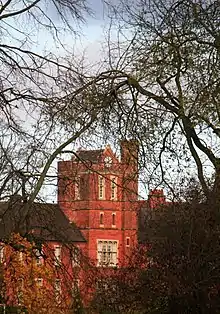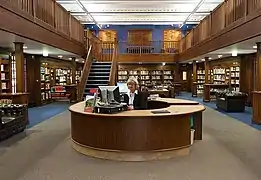Trent College
Trent College is a co-educational independent day and boarding school located in Long Eaton, Derbyshire between Nottingham and Derby. Founded in 1868 as a local ’middle class alternative’ to the more famous public schools, it is now a coeducational school and a member of the Headmasters' and Headmistresses' Conference.
| Trent College | |
|---|---|
 | |
| Location | |

| |
| , , NG10 4AD | |
| Coordinates | 52°53′59″N 1°17′04″W |
| Information | |
| Type | Public School Independent Day and boarding |
| Religious affiliation(s) | Church of England |
| Established | 1868 |
| Founder | Francis Wright |
| Local authority | Derbyshire |
| Department for Education URN | 113004 Tables |
| President | 12th Duke of Devonshire |
| Chair of Governors | Deborah Evans |
| Head | Bill Penty |
| Gender | Co-educational |
| Age | 11 to 18 |
| Enrolment | 1000 plus |
| Houses | 5 |
| Colour(s) | Navy, Red and Gold |
| Publication | The Trident |
| Former pupils | Old Tridents |
| Preparatory school | The Elms School |
| Website | http://www.trentschools.net |
It has over 1000 pupils including 760 pupils in the Senior School and 330 pupils in the Junior School (The Elms School).
On the 28 March 2014, the governors announced that Bill Penty would be taking over as Head from September 2014. Penty was previously Second Master as Sherborne School for Girls in Dorset having also been Head of Languages at Millfield School and Whitgift School.
History

The foundation of Trent College was proposed in 1868 by Francis Wright at a meeting of the Midland branch of the Clerical and Lay Association. His vision was to open a boarding school for "boys of the middle class" as a more affordable alternative to the public schools, and to counter the Anglo-Catholic leaning of the schools set up by the Woodard Trust.[1] The foundation stone was laid by William Cavendish, 7th Duke of Devonshire. Today, the school still retains its ties with the Cavendish family through the Duke's descendant, Peregrine Cavendish, 12th Duke of Devonshire, who is president of the Board of Governors.
The school opened in April 1868 with 53 boys on roll and within four months, the number had risen to 118, and by 1870, 225 boys were registered as pupils. The school’s initial success was hit by the outbreak of scarlet fever in 1873 and the death of its first Headmaster, Thomas Ford Fenn, in 1883. Francis Wright was actively involved with the school until his death in 1873. In 1875 a school chapel was opened in his memory.
In 1975, the school welcomed its first girls into Sixth Form following the trend set by many previously single-sex independent schools. It became fully coeducational in 1992.[2]
The Chapel
The foundation stone of the Chapel was laid after the death of Francis Wright. The building, which cost £300 and was designed by a Mr Robinson of Derby, has been re-modelled three times; first in 1949 by Sir Albert Richardson, president of the Royal Academy, then the chancel was redesigned after a new organ was installed in 1976, and finally in 2001 the pews and lighting were replaced. The west door curtain was a part of the interior of Westminster Abbey at the coronation of Queen Elizabeth II. The wooden collection plates are carved from olive wood from the Garden of Gethsemane outside Jerusalem, where Jesus Christ was arrested before his crucifixion. These were a bequest from the Broadhurst family.
As an Anglican school, pupils are required to attend chapel services throughout the week. In addition, boarders are required to attend Sunday services as well.
Buildings and facilities
The Warner Library was built by pupils in 1929 and contained about 6500 books, fiction, non-fiction and reference materials. The Obolensky, a modern lunch hall/meeting place, was opened in February 2008 and is named after Russian Prince Alexander Obolensky, a former pupil of Trent College. A new library (a sensitive conversion of the former dining hall conserving original wood panelling) was opened in 2010 and is named 'The Duke of Devonshire Library' after the school's president.[3] The former Warner Library was converted into a Computer Science lab in 2016.
 Trent from the top Sports Field
Trent from the top Sports Field The School Library (Opened in 2010)
The School Library (Opened in 2010)
Pastoral Care
Houses
The Trent College House system incorporates all pupils, from Year 7 right through to Year 13. Each student is allocated into one of the 5 houses which can be identified either through the colour of House ties or badges. The houses are named after prominent figures in the history of Trent college.
| House | Color | Namesake |
|---|---|---|
| Cavendish | Purple | William Cavendish, 7th Duke of Devonshire |
| Hanbury | Red | A benefactor to the school and former Chairman of the Governors |
| Kemp | Blue | Sergeant Robert Kemp, in charge of PE, punishment drills and the school postman |
| Owen | Orange | Rev JRB Owen, second headmaster |
| Wright | Green | Francis Wright, founder |
Tutors
Normally pupils have the same tutor in their first year (Year 7); a new tutor for their four years in Senior School and another tutor for their two years in Sixth Form.[6] In summer 2010 the pastoral care programme was rated as 'Excellent' for Pastoral Care and 'Excellent' for Pupils Personal Development by the Independent Schools Inspectorate.
Boarding
Trent has been a boarding school since its foundation and welcomes pupils aged 11 and above. Each boarding house is run by a Head of House and assisted by prefects. The houses can accommodate between 30 and 54 students in modern, well-furnished single or double study bedrooms. Pupils are not required to board and most boarders generally return home for the weekend.
There are four boarding houses at Trent – two houses which have boarders from ages 11–18 (Shuker for boys & Bates for girls), one girls Sixth Form only (Martin) and one boys boarding house from years 11-13 (Blake). The houses are named after prominent figures in the history of Trent college.[7]
Activities
Music
Every year the school hosts a number of concerts which feature its music groups. Many of its students are members ensembles outside of school such as The Nottingham Youth Orchestra and The National Children's Orchestra. The main musical event is the Spring Concert which is held at the Albert Hall annually.[8]
Sport
Trent has a strong sporting tradition and its athletes often compete at county and national level with successful results.[9][10][11] The school has produced a number of successful athletes who have represented England at international level.[12][13]
| Term | Gender | Major Sport |
|---|---|---|
| Michaelmas Term | Boys | Rugby |
| Girls | Hockey | |
| Lent Term | Boys | Hockey |
| Girls | Netball | |
| Trinity Term | Boys | Cricket |
| Girls | Tennis |
On the 29 March 2014 the Rugby 1st XV won the Natwest Cup Vase beating Queen Elizabeth's Hospital Bristol in the Semi-Final and Exeter College in the Final.[14][15]
Notable alumni
Former pupils are known as "Old Tridents" and are entitled membership of the Old Tridents' Society.
- Reginald Philip Abigail, District Commissioner of Arakan during the fall of Burma in 1942[16][17]
- Rex Alston, Cricket commentator
- Albert Ball VC MC, English World War I fighter pilot and flying ace[18]
- John Birch, former Master of the Choristers at Chichester Cathedral
- Sir Howard Colvin, architectural historian
- Harry Daft (1866 – 1945), England footballer
- Thomas Fitton, cricketer and Royal Air Force officer
- David Gillmore, Baron Gillmore of Thamesfield
- Georgia Groome, actress
- Simon Hopkinson, cook and author
- Reverend Kenneth Hunt, England footballer and Olympic gold medallist
- Holly Kenyon, actress
- Clopton Lloyd-Jones, scorer of only goal of 1880 FA Cup Final
- Vivian MacKerrell, actor
- Alexander Obolensky, Russian prince and rugby international[12]
- Kukrit Pramoj, thirteenth Prime Minister of Thailand[19]
- Seni Pramoj, three times Prime Minister of Thailand
- Geoffrey Whitehead, actor
- Dick Parsons (British Army officer), Army marksman
Staff
- Simon Hodgkinson, former England international rugby player
- Abraham Shuker, cricketer and founder of the Trent Association (now called the Old Tridents' Association)[20]
See also
References
- Christian, Roy (1990). Butterley Brick: 200 Years in the Making. Henry Melland. p. 101. ISBN 0907929192.
- "Trent Past". trentcollege.net. Retrieved 14 June 2015.
- "The Duke of Devonshire Library". trentcollege.net. Retrieved 14 June 2015.
- "HMC Independent Day and Boarding School for Boys and Girls". trentcollege.net. Retrieved 14 June 2015.
- "Trent College". Retrieved 14 June 2015.
- "Tutor Care". trentcollege.net. Retrieved 14 June 2015.
- "Boarding Houses". trentcollege.net. Retrieved 14 June 2015.
- "Music". trentcollege.net. Retrieved 14 June 2015.
- "School's double hockey triumph". Nottingham Post. 18 March 2010.
- "Trent College pair get England calls". Nottingham Post. 9 February 2012.
- "Trent girls win Plate final". Nottingham Post. 14 July 2009.
- "Russian prince and England rugby star to be honoured by his former Derbyshire school". Derby Telegraph. 27 February 2009.
- "Former England skipper leads college masterclass". Derby Telegraph. 16 December 2010.
- "Archived copy". Archived from the original on 11 August 2014. Retrieved 2 August 2014.CS1 maint: archived copy as title (link)
- "Archived copy". Archived from the original on 11 August 2014. Retrieved 2 August 2014.CS1 maint: archived copy as title (link)
- "Kelly's Handbook to the Titled, Landed and Official Classes". google.co.uk. 1969. Retrieved 14 June 2015.
- "The India Office and Burma Office List". google.co.uk. 1947. Retrieved 14 June 2015.
- "The boy wonder of the skies who became a legend to rival the Red Baron during the First World War". Derby Telegraph. 10 November 2008.
- "College old boy has historic icon status". Derby Telegraph. 4 December 2009.
- Trent Association Archived 2009-06-06 at the Wayback Machine
External links
- Trent College
- Profile on the ISC website
- ISI Inspection Reports - The Elms School (Junior section) & Senior School